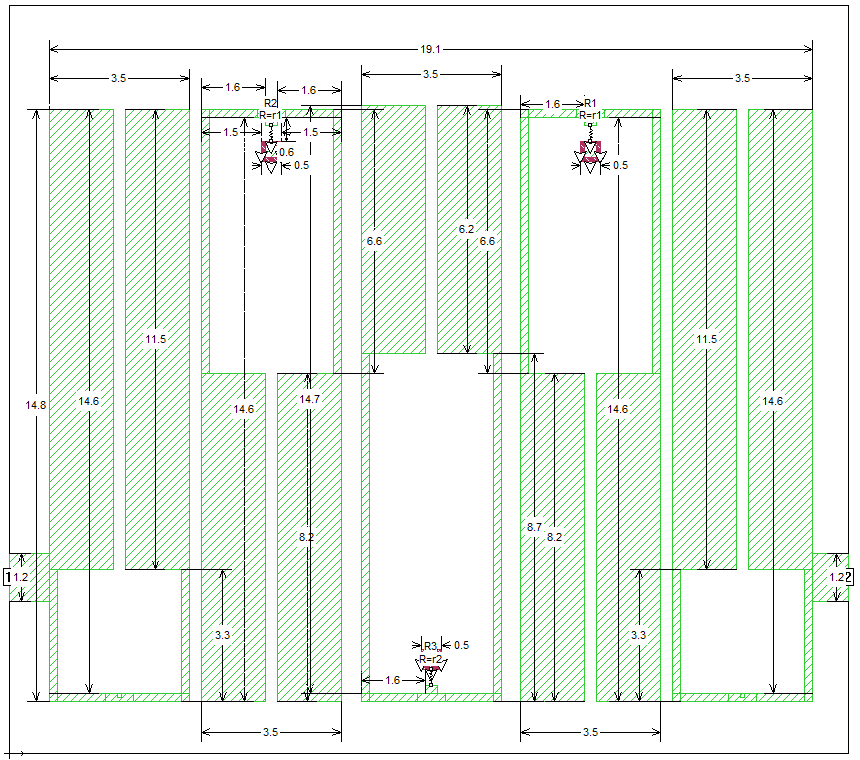New Method for Improving the Passband Flatness in a Microwave Planar Filter
| 694 - Abstract: |
| The present invention relates to an improved radio frequency pass-band filter for use, for example, in a satellite as part of a microwave communications system. This novel method meets stringent requirements for the passband flatness in a microwave planar filter with compact size. Additional improvements in the spurious response are also achieved. ESA is looking for partners who would be interested in getting a license and implementing this patent. |
Description
Microwave passive filters, which are widely used in many wireless communication systems, may be formed from a newtork or configuration of one or more resonators. A significant parameter for describing such a resonator is its Quality (Q) factor, which is defined as the ratio of the stored energy with the resonator divided by the amount of energy lost per cycle. A high Q factor indicates a relatively low level of damping.
Usually, the use of resonators with finite values of Q factor produces two major kinds of undesired features: the lack of flatness in the passband of the transmission parameter, and the increment of the insertion loss level. The insertion loss can be compensated with a subsequent amplification, but the main challenge lies in keeping a certain degree of flatness of the transmission coefficient along the passband.
Filter design is usually a tradeoff between the insertion loss, loss and group delay variation in the passband, isolation, physical dimensions and mass. In the case when additional offset in the insertion loss is tolerated, lossy or predistortion techniques can help to obtain a close to ideal frequency response (high selectivity, isolation and flat amplitude response in the passband) of the filter.
Predistortion and lossy filter techniques are commonly applied to improve the in-band flatness impacting (strongly in the predistortion case) the absolute insertion losses.
The present invention has been developed as a new methodolody to overcome the drawbacks mentioned above.
This is valid in applications where the in-band absolute insertion loss is not a critical parameter, such as in the channelizer or frequency converters, where -as long as the IL (Insertion Loss) is not excessive- it can be recovered by the gain of the LNA (Low Noise Amplifier) / PA (Programmable Amplilfier) without having impact on the system performance.
Moreover these approaches not only improve the filter performance but may also significantly reduce the size and mass of the physical filter, which in satellite applications are very critical considerations.
The present radio frequency passband filter consists of an array of different types of open-loop resonators in a non-transverse topology. The middle resonators are centrally loaded with resistors and with proper loading resistances, the passband flatness can be improved very effectively. The classical lossy technicque are based on either the resistive coupling between resonators or the non-uniform Q distribution in a transverse topology.
The absolute insertion loss and insertion loss variation are comparable to the simulated results in Fig. 2, which effectively proves the proposed concept has great advantage on passband flatness.
Innovations and advantages:
The advantages are in term of size and mass reduction (inherent of lossy/predistortion), reduced complexity (compared with classical lossy/predistortion) and without penalization in terms of return loss.
The mass and footprint of frequency converters (and in general low frequency RF equipment) at low frequency is usually big. The application of this invention will bring a high degree of compactness for the filter structures while having good in-band performances (return loss and insertion loss variation).
Domain of application:
- The invention is applicable to any low frequency filter with planar implementation where good insertion losses are required.
- Additionally, the invention provides an improvement in terms of out of band rejection with respect to classical planar implementations.
IP Status
European and US patent applications have been filed.















 Germany
Germany
 Austria
Austria
 Belgium
Belgium
 Denmark
Denmark
 Spain
Spain
 Estonia
Estonia
 Finland
Finland
 France
France
 Greece
Greece
 Hungary
Hungary
 Ireland
Ireland
 Italy
Italy
 Luxembourg
Luxembourg
 Norway
Norway
 The Netherlands
The Netherlands
 Poland
Poland
 Portugal
Portugal
 Czechia
Czechia
 Romania
Romania
 United Kingdom
United Kingdom
 Slovenia
Slovenia
 Sweden
Sweden
 Switzerland
Switzerland


























